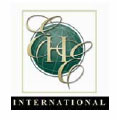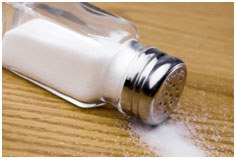
Salt and Sodium
Salt is a mineral that is composed primarily of sodium and chloride. It is the world’s
oldest food additive and has played a key role in food safety and preservation for
thousands of years by inhibiting the growth of microorganisms that cause spoilage.
Today, refrigeration, modern canning and other food processing techniques have made
this once essential preservative role of salt largely superfluous.
Why is Sodium Important?
 Sodium is an essential nutrient as it is required by the body to perform a variety
of essential functions. Sodium plays an important role in maintaining the body’s
fluid balance and is essential for muscles and nerves to function properly. Without
it, the body would not be able to maintain adequate water and mineral balance, the
absorption of major nutrients would be impaired and nerves and muscles would cease
to function.
Sodium is an essential nutrient as it is required by the body to perform a variety
of essential functions. Sodium plays an important role in maintaining the body’s
fluid balance and is essential for muscles and nerves to function properly. Without
it, the body would not be able to maintain adequate water and mineral balance, the
absorption of major nutrients would be impaired and nerves and muscles would cease
to function.
Too Much Sodium
While sodium is an essential nutrient, too much sodium in the body is bad for overall
health. Diets that are high in sodium are major causes of high blood pressure and
pre–hypertension, both of which significantly increase the risk of heart attack
and stroke. According to the Centers for Disease Control and Prevention (CDC), research
shows that a dose–dependent relationship exists between high sodium intake and elevated
blood pressure. When sodium intake is reduced, blood pressure begins decreasing
for most people within a few days to weeks.
Recommended Intake
In February of 2004, the Food and Nutrition Board of the Institute of Medicine (IOM)
released the Dietary Reference Intakes for Water, Potassium, Sodium, Chloride and
Sulfate report. The report stated that a Recommended Dietary Allowance (RDA) for
sodium could not be derived. Instead, an Adequate Intake (AI) was provided which
recommended 1,500 mg of sodium per day for young adults and even less for individuals
aged 50 and over. The report set a tolerable Upper Limit (UL) for sodium at 2,300
mg per day. According to a recent report by the Institute of Medicine (IOM), however,
Americans consume an average of more than 3,400 mg of sodium per day, an amount
which far exceeds the recommended sodium intakes and the UL. As this estimate is
from self–reported intakes and does not include any salt added at home, actual intakes
may be much higher.
In its Dietary Guidelines for Americans, 2005 publication, the Dietary Guidelines
Advisory Committee (DGAC) recommended a daily sodium intake of less than 2,300 mg
per day for the general adult population and a daily sodium intake of 1,500 mg per
day for hypertensive individuals, African–Americans and middle–aged–or–older adults.
As these latter groups together now comprise nearly 70 percent of the U.S. adult
population, the 2010 DGAC has recommended that the daily sodium intake goal be reduced
to 1,500 mg per day for the general population.
Sources of Salt
Since the body cannot create sodium, individuals rely on food to ensure adequate
intake. In most modern cultures, about 12 percent of dietary sodium intake comes
naturally from whole unprocessed foods, 11 percent comes in the form of salt that
is added during cooking or during a meal at home and the remaining 77 percent comes
in the form of salt that is added to processed foods and meals consumed away from
the home.
Increased salt consumption in the U.S. has been shaped in part by changes in eating
habits as individuals consume more processed foods, dine out more frequently and
prepare fewer meals from basic, raw ingredients at home. Due to these trends, individuals
have gradually grown accustomed to saltier foods as the amount of salt in the nation’s
food supply has increased over time. According to the IOM, however, research indicates
that this trend can be reversed. Through subtle reductions over time, individual
tastes can be ‘reset’ to prefer less salty flavor. A main obstacle to salt reduction
is the fact that most sodium is well–hidden in packaged foods, processed foods and
restaurant foods. Limiting it, therefore, can often be difficult and may result
in frustration for those whose try.
Benefits of Reducing Salt Intake
An article published in the February 18, 2010 New England Journal of Medicine (NEJM)
titled "Projected Effect of Dietary Salt Reductions on Future Cardiovascular Disease"
reported that a reduction in dietary salt intake of 3 grams per day (1/2 a teaspoon
of salt) would result in substantial reductions in the incidence of coronary heart
disease, stroke and death. The article projected that there would be a reduction
in the annual number of new cases of Coronary Heart Disease (CHD) by between 60,000
and 120,000, a reduction in new cases of stroke by between 32,000 and 66,000 and
a reduction in new cases of myocardial infarction (heart attack) by between 54,000
and 99,000. A reduction of between 44,000 and 92,000 was also projected for the
annual number of deaths from any cause. According to the article, all segments of
the population would benefit, with African–Americans benefiting proportionately
more, women benefiting particularly from stroke reduction, older adults benefiting
from reductions in CHD events and younger adults benefiting from lower mortality
rates. Additionally, the article stated that the cardiovascular benefits of reduced
salt intake would be on par with the benefits of population–wide reductions in tobacco
use, obesity and cholesterol levels. The study was conducted by scientists at University
of California San Francisco, Stanford University Medical Center and Columbia University
Medical Center.
The article arrives at a time when health authorities at federal, state and municipal
levels are considering policies that would pressure food companies to reduce salt
in processed foods — considered to be the source of much of the salt that Americans
consume. Recently, the IOM issued a report which outlined strategies to reduce sodium
consumption to levels recommended by the Dietary Guidelines for Americans. The report
indicated that, despite efforts to reduce sodium intake in the U.S. for more than
40 years, the efforts have been unsuccessful because they were not broad enough
in scope to fully address the public health problem of excessive sodium intake.
The IOM believes that the level of sodium to which consumers are exposed on a daily
basis from processed and restaurant foods must be reduced. The IOM also made a series
of recommendations, many of which involved regulatory actions to gradually lower
the sodium content of the food supply.
Earlier in the year, New York City announced an initiative to urge food manufacturers
and restaurant chains to reduce salt in their products by 25 percent over the next
five years. According to an author of the NEJM study, Kirsten Bibbins–Domingo, an
associate professor of medicine and epidemiology at The University of California,
San Francisco, the state of California is considering setting salt limits on foods
that the state purchases for schools, prisons and other public institutions.
How to Cut Back on Sodium
Eliminating the salt added during cooking and meals at home will only reduce sodium
intake by 11 percent and will not help the average American reach the recommended
daily intake. Knowing where to look for sodium content in foods and understanding
how to effectively reduce intake is important.
Sodium is present in additives such as monosodium glutamate (a flavor enhancer),
sodium saccharin (a sweetener), sodium nitrite (a preservative), sodium ascorbate
(an antioxidant), sodium bicarbonate (baking soda) and in some medicinal products
such as antacids. Most sodium in the average diet, however, comes from salt. Many
canned and frozen foods contain 1,000 mg or more of sodium in an eight–ounce serving.
Consumers must read food labels very carefully to determine the sodium content of
food (which can vary by several hundreds of milligrams among similar food items)
and select lower–sodium products. This diligence can be difficult, however, as products
that are low in sodium are often difficult to find and can be more expensive. Additionally,
restaurant meals — which are not labeled — often contain 3,000 mg or more of added
sodium without the consumer’s knowledge.
The following are suggestions for reducing daily sodium intake:
At home:
- Limit use of sodium–laden condiments. Items such as soy sauce, lite soy sauce, tamari,
salad dressings, sauces, dips, ketchup, mustard and relish all can contain high
levels of sodium.
- Make recipes from scratch.
- Avoid salting food.
- Use spices other than salt when cooking. Examples include pepper, basil, thyme,
garlic and other salt–free spice mixes (i.e., Mrs. Dash).
- Use herbs, spices and other flavorings to enhance foods. Fresh or dried herbs, spices,
zest from citrus fruit and fruit juices can all enhance meals.
- Use salt substitutes wisely. Some salt substitutes or light salts contain a mixture
of table salt and other compounds. Many salt substitutes contain potassium chloride.
Although potassium can lessen some of the problems from excess sodium, too much
potassium can be harmful among individuals with kidney problems or individuals who
take medications for congestive heart failure or high blood pressure.
When Eating Out:
- Ask that food be prepared without adding any salt and request the use of other spices
instead. Most restaurants will agree to do this and will suggest alternative items
as well.
- Since most restaurant foods already have too much sodium, limit or avoid adding
any additional salt at the table.
When Shopping:
- When buying processed foods in a supermarket, select ones that are the lowest in
sodium. The simplest method for doing this is to use the 1:1 guideline. Look for
products in which the amount of sodium in milligrams (mg) per serving is less than
or equal to the number of calories per serving. For example, if a product has 100
calories per serving, it should have no more than 100 milligrams of sodium per serving.
While it will be difficult to find many products that meet this guideline, the closer
that a product comes to meeting it, the better. Using this guideline will also help
identify the product with less sodium when choosing between two similar products.
- Purchase and consume more fresh foods and fewer processed foods. Fruits, vegetables,
starchy vegetables, intact whole grains and legumes are the foods that are the lowest
in sodium. They are also rich sources of many other nutrients that are important
in maintaining healthy blood pressure and overall good health.
- Avoid processed meats, fresh and frozen poultry or meat that has been injected with
a sodium–containing solution. Look on the label or ask the butcher.
- Remember that sodium chloride is sodium chloride and it does not matter if it is
in sea salt or table salt form; they both have the same basic nutritional value.
Sea salt, however, is often marketed as a healthier, more natural alternative. The
real differences between sea salt and table salt are in their taste, texture and
processing — not their chemical makeup. Choosing to use sea salt as the source of
sodium intake is a personal preference, but it is not any healthier or safer than
table salt.
Most Americans consume more than double the amount of their daily recommended level
of sodium. In the U.S., 16 million men and women have heart disease and 5.8 million
are estimated to have had a stroke. These ailments are the first and third–leading
causes of death in the U.S. It is important for individuals to know their recommended
daily sodium limit and take action to reduce sodium intake. Individuals who do so
will benefit from improved blood pressure and a reduction in the risk of developing
other serious health problems.